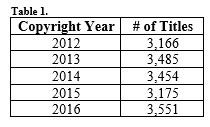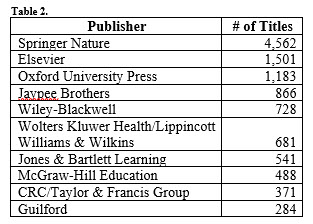Nearly 13 years ago, Dan Doody and I decided to build a consulting practice as a spinoff from Doody Enterprises. The time seemed propitious -- the organization of healthcare itself was changing, publishers were merging into ever-larger behemoths, and by 2004 it was clear that the digital revolution in books had finally arrived, probably a decade later than in journals.
As consultants, Dan and I have stayed busy helping our clients - primarily professional associations in the health sciences - keep pace with the changing publishing landscape. This led me to wonder how much the changing landscape is influencing the health sciences book publishing industry. With the assistance of Doody's editor in chief, Anne Hennessy, I set out to take a quick look, focusing on the five-year period from 2012 through 2016.
Anne helped me organize the vast amount of data in the Doody product database, sorting data on the books that arrived physically (occasionally, digitally) in the Doody offices. Although a little less than 100% of all new books are sent directly to the Doody office - here and there, a small publisher forgets to send titles - this is a valuable data source, for two reasons: first, any given title is typically recorded under only one ISBN, so the Doody numbers represent unique products. As most people in the book trade know, a single unique book can spawn several ISBNs, based on different bindings, package deals, and versions, so if we just count ISBNs recorded by the book trade, the numbers can be misleadingly high. Moreover, different publishers have different practices when it comes to assigning multiple ISBNs, so the numerical inflation varies a good bit. Second, Anne herself assigns subject categories to all books that Doody receives, so the definition of a particular specialty (e.g., "general surgery") is consistent across the five years, and from publisher to publisher.
I spent a couple of hours staring at big spreadsheets until I saw patterns, and now I'd like to share what I observed.
The first and perhaps most surprising observation is that the total number of book titles across all of the health sciences is fairly stable. Table 1 tells the story:

In terms of the number of titles published over the five-year period, the top publishers are shown in Table 2 below.

Most people in health sciences publishing would guess that Springer Nature publishes the most titles, but would anyone think they publish three times as many as the next most prolific publisher? Springer accomplished this the old-fashioned way – they grew at an incredible pace. In 2012, Doody received 468 titles from Springer, and by 2016 the number was up to 1166; that’s 149% growth in five years. And this number doesn’t even take into account titles under the Humana imprint, which Springer acquired three years ago.
The other surprise in this table could be the fourth-place position of the Indian publisher Jaypee Brothers, with 866 titles in the five-year period. In the previous five-year period, Doody received 192 titles from Jaypee, so its output is now about 4.5 times what it was. Its office in London has grown, and for a time they had a small outpost in Philadelphia, but our impression is that most of the growth has come from the India-based publishing program. This says a lot about the huge and growing medical book market in India.
By the way, I left a giant source of titles that factored into Table 1 out of Table 2: GIDEON Informatics, which stands for Global Infectious Diseases and Epidemiology Network. GIDEON calls itself "the world's premier infectious diseases database." In 2016, Doody recorded books from GIDEON for the first time - a whopping 423 of them. They are all ebooks, each essentially summarizing the state of the art for a particular bug, ranging from acanthocephalan worms to yersiniosis. Presumably someone at GIDEON pushed a button, and their database populated a book template 400-plus times. Is this book publishing? It’s not what I grew up with, but can you argue that it’s not book publishing?
For what it's worth, the huge number of titles from the "new" publisher GIDEON accounts for the apparent bump in publishing activity from 2015 to 2016 seen in Table 1. The rest of the industry slid just a hair from 2015 to 2016, well within the historical year-to-year wobble.
Within this fairly stable industry, there are some interesting patterns on a subject-by-subject basis. For instance, in Doody's Clinical Medicine category, there are significant winners and losers among specialties. In terms of numbers of titles, the fastest growing specialties have been:
- Dermatology: Up 83% (41 titles in 2012 to 75 titles in 2016)
- Plastic & Reconstructive Surgery: Up 71% (14 to 24 titles)
- Otolaryngology - Head & Neck Surgery: Up 61% (41 to 66 titles)
- Urology: Up 48% (27 to 46 titles)
- Orthopedic Surgery: Up 38% (81 to 112 titles)
- Diagnostic Radiology: Up 32% (93 to 123 titles)
Is it any coincidence that the rapid growth has taken place exclusively in high-paying, high-tech specialties? There are always new wrinkles to publish about, and marketing departments at publishing companies have traditionally targeted the disposable incomes of the core audience. Now, Doody doesn't have access to revenue figures, so it's not fair to conclude that the markets are growing rapidly – only that the acquisitions editors in these specialty areas seem to be running faster and faster.
The specialties that have declined the most over the five-year period are the following:
- Family Practice: Down 61% (18 to 7 titles)
- Nutrition: Down 35% (26 to 17 titles)
- Anesthesia: Down 34% (62 to 41 titles)
- Rheumatology: Down 33% (24 to 18 titles)
- Pediatrics: Down 22% (91 to 71 titles)
For the most part, these are specialties with relatively low compensation, and without a lot of technological bells and whistles. Anesthesia seems to be an outlier here since it's a well- compensated specialty area. However, at the clinical level there haven't been a lot of advances in anesthesiology in recent years, so it may be harder to find topics that call for new titles.
Finally, it's clear that there's a considerable range of titles per specialty. Over the last five years, here are the medical specialties with the most titles:
- Psychiatry: 825
- Diagnostic Radiology: 550
- Neurology: 524
- Orthopedic Surgery: 524
- Cardiology: 492
This list reaffirms the stereotype of the psychiatrist in a book-lined office. (Think about
New Yorker cartoons.) And neurologists also have a reputation as bookish people. Diagnostic radiology, orthopedic surgery, and cardiology are all high-earning specialties involving both technique and technology.
The most obvious conclusions to be drawn from this exercise are that the (medical) book does not appear to be dying and hope springs eternal at publishing companies. Apparently, there are still thousands of authors who want to write books. However, I'm keeping my eye on books as commodities – the GIDEON "publishing program," the ever-more-frenetic pace at Springer Nature, even the host of little handbooks and review books at Jaypee. Will products of this kind overtake our image of the author laboring late at night and over the weekends to create something new? For now, it's not a proven trend, merely something worth keeping our eyes on.
Doody's Core Titles Newsletter would welcome the views of collection development librarians on the trends you see in health sciences book publishing over the last five years or so. Are you interested in contributing your own article to this dialogue? If so, please contact dan@doody.com.